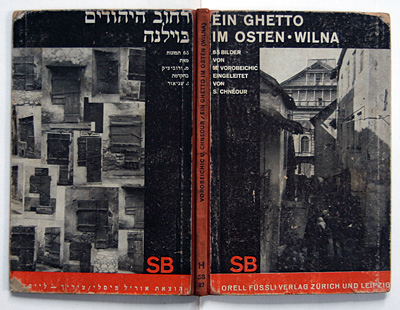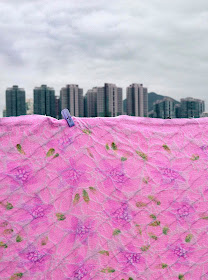Birds door André Kertész (Auteur)
Mayflower Books (1979), Editie: First Edition, 64 pagina's
See also
Views & Reviews Unmasking a Chameleon of the Lens Landscapes André Kertész Photography
Americana 10 Lessons Andre Kertesz Has Taught Me About Street Photography Eric Kim André Kertés |
...a photoBook is an autonomous art form, comparable with a piece of sculpture, a play or a film. The photographs lose their own photographic character as things 'in themselves' and become parts, translated into printing ink, of a dramatic event called a book... - Dutch photography critic Ralph Prins
dinsdag 30 april 2019
Birds André Kertész Street Photography
zaterdag 27 april 2019
Michael Wolf (1954-2019): Intimate Portraits of Cities of millions Photography
Photographer Michael Wolf dies at age 65
Local | 26 Apr 2019 12:51 pm
Hong Kong-based German photographer Michael Wolf has died in his apartment in Cheung Chau at the age of 65.
Fotomuseum Den Haag, a photography museum in the Netherlands, said it received the news yesterday.
Wolf was born in 1954 in Munich and grew up in the United States and Canada, but returned to Germany for his studies. He started his career as a photojournalist and had worked magazines including Geo and Stern.
Since 1994, Wolf has lived and worked in Hong Kong. From 2003, he started to work on his own projects. In the city, Wolf produced his renowned photography series, Architecture of Density (2003 – 2014).
In 2005 and 2010, Wolf won the first prize at World Press Photo, and he also received an honorable mention in 2011. In 2010 and 2016, Wolf was nominated for the Prix Pictet photo prize.
How photographer Michael Wolf captured the melancholy of our teeming cities
From Japanese commuters pressed against train windows to the high-rise hutches of Hong Kong, the German photographer caught the effects of global capitalism on humans
Sean O'Hagan
Fri 26 Apr 2019 16.45 BST Last modified on Fri 26 Apr 2019 17.40 BST
Playfully anthropological ... Michael Wolf at the V&A, London, in 2017. Photograph: Jeff Spicer/Getty Images
Michael Wolf, who has died suddenly, aged 64, was perhaps best known for his 2013-14 series, Architecture of Density, in which the facades of Hong Kong’s massive tower blocks, each one housing thousands of people, appear as dramatic geometric abstractions of light and colour. Hong Kong’s population density is around 6,987 people per square kilometre, and many of them live in tiny flats in these massive buildings. In Wolf’s photographs, the people are invisible, but on closer inspection, their presence is evident everywhere – in the coloured curtains, the laundry hanging out to dry, the sheets that drape on scaffolding.
The series brought Wolf critical acclaim and positioned him firmly in a German tradition: the detached formalism of the Dusseldorf School – Bernd and Hilla Becher, Thomas Struth, Andreas Gursky and the rest. He was, though, more mischievous and playfully anthropological than that. His subsequent series, 100x100, was, he said, a response to the question he was most often asked about Architecture of Density: “How do people live in there?” The title referred to the number of images he selected, but also to the measurement (10 x 10 feet) of each of the 100 identical designed rooms in the vast Shek Kip Mei public housing complex. Here, amid portraits of the inhabitants, it was the tiny decorative details of each makeshift living space that lent the work its humanity.
Wolf identified the abiding theme of his work as life in cities and his other signature work, Tokyo Compression, captured the claustrophobic experience of the Japanese capital’s subway system during rush hour. Here the hyperdensity of the postmodern city gives way to a series of portraits of individual endurance, with each face pressed tight against the glass of an ominously overcrowded carriage, offering a Ballardian glimpse of a daily ritual that, in Wolf’s portraits, is by turns intimate and unsettling. Some faces are blurred by the condensation on the windows, others stare implacably at his camera or seem lost in reverie. Some simply close their eyes as if to block out his presence. In 2011, Martin Parr included Tokyo Compression in his 30 most influential books of the previous decade.
Wolf’s work at the Rencontres d’Arles photography festival in France. Photograph: Ullstein Bild via Getty Images
Born in Germany in 1954, Wolf was brought up in North America and Europe. He studied visual communication at the University of Essen under the influential Otto Steinert, a pioneer of photographic abstraction. Wolf worked as a photojournalist for Stern magazine for almost 10 years, before making the transition to art photographer. His early breakthrough project, The Real Toy Story, comprised of 16,000 Chinese-made toys, which he exhibited by attaching each one individually to the walls of a gallery with magnets. Alongside them, he showcased his portraits of the Chinese conveyor-belt workers who mass-produced the cheap toys for the western market.
Michael Wolf's best photograph: four plucked ducks in Hong Kong
Though seldom commented on by art critics, there was a political undertone to Wolf’s work. In several of his best-known series, even the ones where people were an invisible presence, his striking images point to the human cost and extraordinary resilience of contemporary city dwellers caught up in the Darwinian thrust of global capitalism. For every epic project like Architecture of Density, there were intimately observed series’ created during his various trawls through Hong Kong’s back alleys. There, he caught telling glimpses of the city’s makeshift character: customised chairs, surreal arrangements of kitchen mops and wire coat hangers, twisting gas and water pipes, all the mundane everyday objects that speak of the relentless resourcefulness of its residents, and of Wolf’s eye for accidental sculptural beauty amid the seemingly mundane. A detached gaze, yes, but an expressively tender one all the same. It will be missed.
Michael Wolf (1954-2019): intieme portretten van miljoenensteden
De Duitse fotograaf en kunstenaar Michael Wolf is op 64-jarige leeftijd overleden. Wolf fotografeerde het drukke stadsleven, in de vorm van kleurrijke flatgebouwen die zich tot in het oneindige lijken uit te strekken. Andere keren zoomde hij juist in op individuen en hun dagelijkse levens in grote metropolen. Wolf werkte in zijn woonplaats Hong Kong, maar ook in Tokio, Parijs en Chicago.
26 april 2019 om 11:16
See also
Views & Reviews The Photographer of Everyday Life in Cities Paris Tokyo Michael Wolf Photography
Wolkenkrabbers in Hong Kong, uit de fotoserie 'Architecture of Density' (2009).
Michael Wolf/laif/HH
Man in Hong Kong doet een dutje tijdens zijn lunchpauze (2015).
Michael Wolf/laif/HH
Opslagruimte in Hong Kong, uit de serie 'My Favorite Things' (2013).
Michael Wolf/laif/HH
Waslijn in Hong Kong, uit de serie 'My Favorite Things' (2014).
Michael Wolf/laif/HH
Vrouw in het openbaar vervoer in Tokio, uit de serie 'Tokyo Compression' (2009).
Michael Wolf/Laif/HH
Foto gemaakt boven de daken van Parijs (2014).
Michael Wolf/laif/HH
Handschoenen aan de waslijn in Hong Kong, uit de serie 'My Favorite Things' (2014).
Michael Wolf/laif/HH
Flatgebouw in Chicago, uit de serie The Transparent City (2009).
Michael Wolf/laif/HH
Inkijk in flatwoning in Chicago, uit de serie The Transparent City (2009).
Michael Wolf/laif/HH
Kantoorgebouw in Chicago, uit de serie The Transparent City (2009).
Michael Wolf/laif/HH
Michael Wolf fotografeerde mensen die klem zitten
Michael Wolf 1954-2019 De Duitse fotograaf en beeldend kunstenaar Michael Wolf is op 64-jarige leeftijd overleden. Hij stond vooral bekend om zijn fotoseries van de eindeloos uitstrekkende flatgebouwen in zijn woonplaats Hongkong.
Paul Steenhuis
26 april 2019 om 11:51
De Duitse fotograaf en kunstenaar Michael Wolf is dinsdag in zijn appartement in Hongkong overleden. Hij was 64 jaar. Dat meldt het Haags Gemeentemuseum, mede namens zijn galeriehouder.
Sinds 1994 woonde en werkte de in München geboren Wolf in Hongkong. Die stad met ruim zeven miljoen inwoners werd zijn belangrijkste inspiratiebron. Hij maakte daar onder meer zijn beroemdste fotoseries van eindeloze kleurige wolkenkrabbers en inkijkjes in flatwoningen, Architecture of Density.
Sociaal geëngageerd
Die serie was onderdeel van de grote overzichtstentoonstelling die het Haags Gemeentemuseum met hem maakte, Michael Wolf - Life in Cities. Die was als eerste te zien op het fotofestival in Arles en daarna, begin 2018, onder meer in het Fotomuseum Den Haag. Speciaal onderdeel van die expositie was een enorme wand met in China gemaakt plastic speelgoed, met sociaal bewogen foto’s van Wolf van mensen uit de plastic-industrie. Het was zijn eerste grote installatie, en debuut als beeldend kunstenaar.
Wolf begon ooit als fotojournalist, voor bladen als Stern en Geo. Zijn werk, altijd geënt op sociaal geëngageerde documentaire-fotografie, is opgenomen in vele musea, zoals het MoMA in New York en het Rijksmuseum. Hij won vele prijzen, zoals de eerste prijs bij World Press Photo in 2005 en 2010. Hij maakte een groot aantal fotoboeken, zoals Tokyo Compression, met foto’s van mensen die klem zitten in de metro in Tokio.
Michael Wolf laat een vrouw en kind achter.
donderdag 25 april 2019
Ein Ghetto im Osten Wilna by Moshe Vorobeichic & S. Chnéour Photography
moshe vorobeichic, s. chnéour:
ein ghetto im osten – wilna
orell füssli verlag, zürich/leipzig (schaubücher 27), 1931
size: 19 x 13 cm
photographer: moi ver designer : (unknown)
M. Vorobeichic, who also used the artist name Moi Ver, and whose real name was Moses Vorobeichic (1904), in Israel renamed Moshe Raviv. This painter/photographer is known for his picture-books on the Ghetto of Wilna and Paris (end of the twenties), early examples of the Bauhaus photographic style. (German) From the Preface The Jewish Lane in Light and Shadow by S. Chneour
About Paris : 'The book that introduced Moi Ver to the world is exhilaratingly eccentric, definitely avant-garde.... Moi Ver's Paris is a city in motion, hurtling almost out of control. Cobblestone streets, bustling crowds, facades, railway tracks, bridges. the glittering river, and countless monuments shift and shatter here.... Moi Ver's version of Paris was eclipsed two years later by the publication of Brassai's more conventionally seductive Paris de Nuit, but no one has yet matched Moi Ver's vision of the brutal, chaotic, irresistible modern city.'-Vince Aletti, from the Book of 101 Books
In Paris, his quintessential avant-garde book, Moi Ver succeeded in blending dynamic photographic montage with elaborate graphic layouts. Utilizing the double-spread as one unified place, each turn of the page not only surprised but accentuated the charged rhythm built into the book itself. The bulk of information in these pictures documents mundane street activities in the cobblestone-covered Paris of the late 20s. But the method in which Moi Ver chose to present his material, in its kaliedoscopic layering and frenzied repetitiveness, emphasized an experiential approach to picture construction-as if we, the viewers, were walking about, bombarded by noise and reflected light. Originally published in 1931 by Editions Jeanne Walter with an introduction by Futurist Fernand Leger, now long out of print and exceptionally rare, this facsimile reproduction of Paris brings back into circulation one of the seminal photographic books of the century. See for the slideshow ...
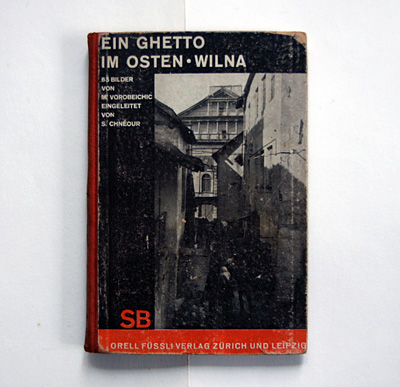
another example of orell füssli's "schaubücher" (sb), a series of photo books with laminated board covers in a standardised new typography design, see also books 95, 173 or 96.
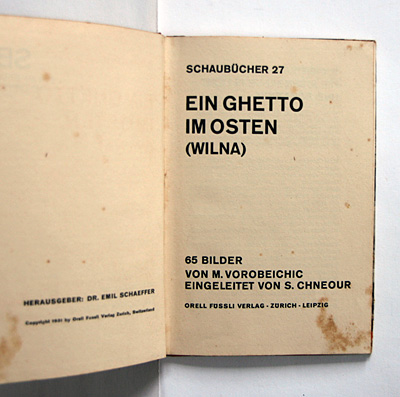
sb edition number 27 is a standout and the most sought after: it is a photo documentation of the jewish ghetto of vilnius, the lithuanian city which is called "wilna" in german.
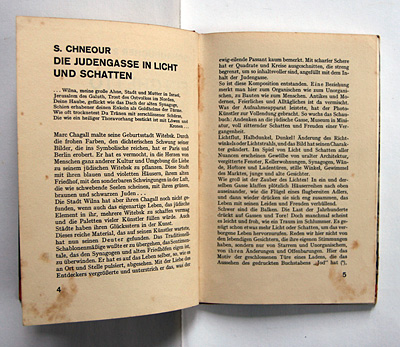
the introduction was written by zalman shneour (1887-1959), a jewish (yiddish) writer who lived in vilnius and later in paris.
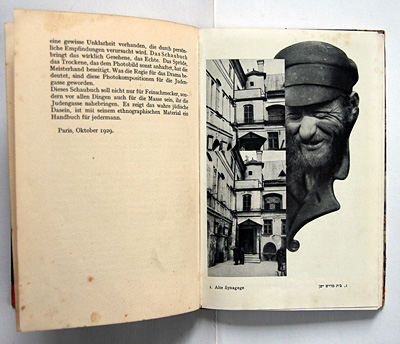
the book is famous for its photos by moshe raviv-vorobeichic (1904-1995), better known as moi ver.
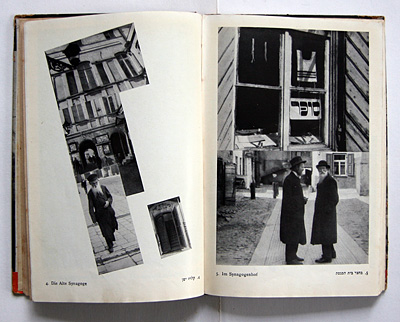
moi ver had studied at the bauhaus in dessau, and later worked in paris before finally settling in palestine.
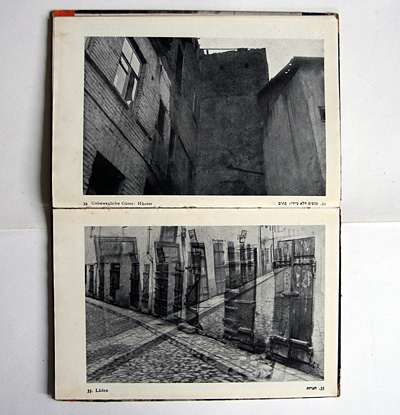
the experimental photos and photomontages reveal a bauhaus influence.
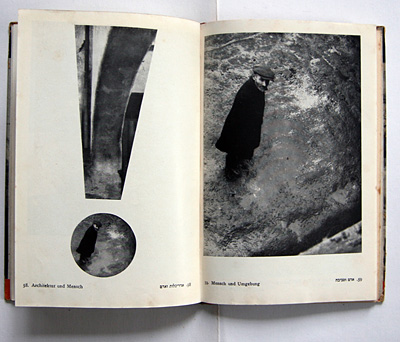
a unique feauture of this "schaubuch": ...
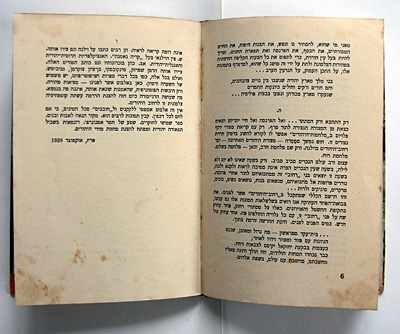
... the whole book is bilingual, ...
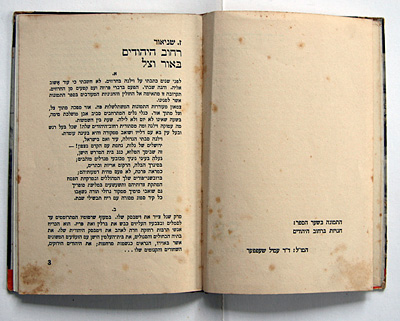
... german and hebrew!
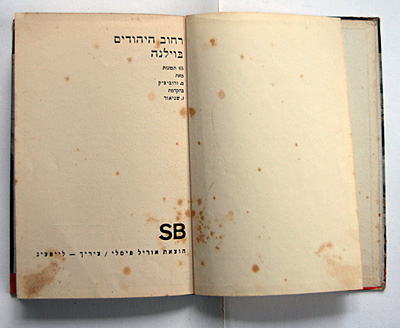
the hebrew version starts at the "back".
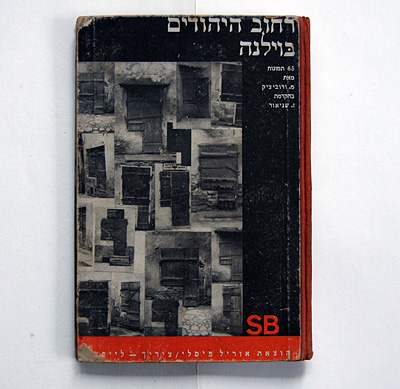
a stunning book about a fascinating world which was wiped out by the nazis in ww2.
